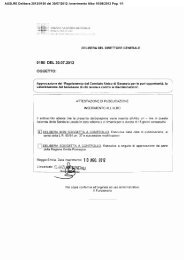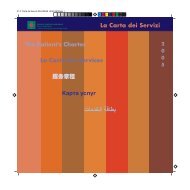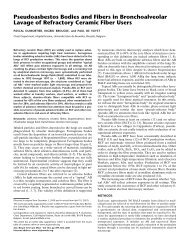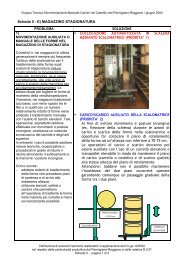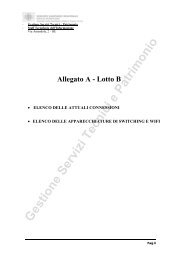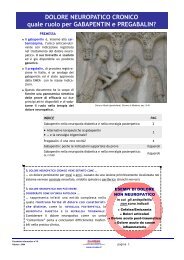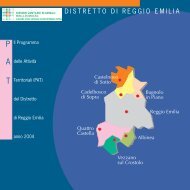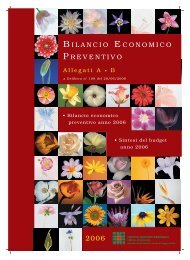Methods for the determination of the hazardous properties - TSAR
Methods for the determination of the hazardous properties - TSAR
Methods for the determination of the hazardous properties - TSAR
Create successful ePaper yourself
Turn your PDF publications into a flip-book with our unique Google optimized e-Paper software.
ECB/TM/26 rev.7<br />
1.4.4.2.2 1.4.4.2.2 FIBRE AND PARTICULATE NUMBER (fibres/cm 3 ) AND BIVARIATE SIZE DISTRIBUTION (µm)<br />
BY SCANNING ELECTRON MICROSCOPY (SEM)<br />
These should be sampled at least twice per day. These samples should be taken in timely coincidence with<br />
<strong>the</strong> gravimetric sampling with sample duration dependent upon fibre type (usually less than 30 minutes).<br />
One filter per day should be analysed <strong>for</strong> fibre and particulate number, with <strong>the</strong> remaining filters used if<br />
anomalies are found. Bivariate analysis <strong>of</strong> diameter and length should be determined at least twice weekly<br />
with <strong>the</strong> additional filters used if anomalies are found. Fibre concentration should be expressed as total<br />
number <strong>of</strong> fibres/cm 3 and <strong>the</strong> number <strong>of</strong> fibres/cm 3 with length > 20 µm, 5-20 µm, < 5 µm and WHO<br />
fibres and <strong>the</strong> number <strong>of</strong> particles/cm 3 .<br />
1.4.4.2.3 CHEMICAL ANALYSIS<br />
One filter sample should be taken <strong>for</strong> possible analysis.<br />
1.4.4.3 Counting and Sizing Rules (<strong>for</strong> aerosol and lung fibres)<br />
The general guidelines provided by <strong>the</strong> WHO/EURO (reference (1)) are recommended with <strong>the</strong> following<br />
additional procedures <strong>for</strong> mineral fibres (due to <strong>the</strong> possibility <strong>of</strong> smaller diameters, additional procedures<br />
may be required <strong>for</strong> natural or organic fibres).<br />
1.4.4.3.1 LENGTH AND DIAMETER<br />
Sizing <strong>of</strong> length and diameters should be per<strong>for</strong>med using a SEM at a magnification <strong>of</strong> at least 2000. All<br />
objects which are seen at this magnification are to be counted. Fibres crossing <strong>the</strong> boundary <strong>of</strong> <strong>the</strong> field <strong>of</strong><br />
view should be counted as follows. Fibres with only one end in <strong>the</strong> field are weighted as half <strong>of</strong> a fibre<br />
and fibres with nei<strong>the</strong>r <strong>of</strong> <strong>the</strong>ir ends in <strong>the</strong> field are not measured. Diameters <strong>of</strong> fibres which are seen at<br />
2000 magnification should be measured at ‘full screen’ magnification (usually up to a magnification <strong>of</strong><br />
10,000). No lower or upper limit is to be imposed on ei<strong>the</strong>r length or diameter. For bulk fibres with mean<br />
diameters below a few tenths <strong>of</strong> a micrometer, an initial magnification <strong>of</strong> at least 5000 should be used.<br />
The length and diameter are to be recorded individually <strong>for</strong> each fibre measured so that <strong>the</strong> bivariate<br />
distribution can be determined. When sizing, an object is to be accepted as a fibre if <strong>the</strong> ratio <strong>of</strong> length to<br />
diameter was at least 3:1. All o<strong>the</strong>r objects are considered particles. There should be no truncation in <strong>the</strong><br />
measurements. If fibre measurements are made using SEM photomicrographs or video prints where <strong>the</strong><br />
magnification <strong>of</strong> <strong>the</strong> photo or print is at least twice that <strong>of</strong> <strong>the</strong> SEM screen, <strong>the</strong>n an initial SEM<br />
magnification <strong>of</strong> at least 1000 is acceptable, providing fibres <strong>of</strong> 0.1 µm diameter can be resolved. When<br />
using photomicrographs or video prints, higher magnifications should be used <strong>for</strong> diameter measurement<br />
than <strong>for</strong> length measurement in order to ensure good precision.<br />
1.4.4.3.2 STOPPING RULES<br />
Enough fields <strong>of</strong> view are to be counted <strong>for</strong> evaluation so that at least a total <strong>of</strong> 0.15 mm 2 <strong>of</strong> <strong>the</strong> filter<br />
surface (<strong>for</strong> 25 mm diameter) is examined. Once this condition is fulfilled:<br />
- 20 -



